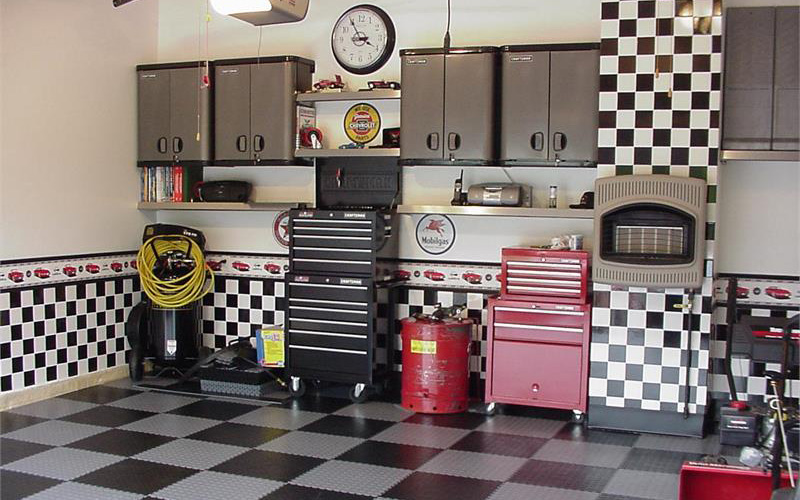Tips for Installing Tile
Installing tile in a kitchen or bathroom is hard work. This collection of tips may not eliminate all your tile troubles, but it will help you avoid the most common headaches.
Mix it smooth
After all the prep and layout work, you’re finally ready to set tile and see some results. The last thing you want to do is stop and wait. But giving the thinset time to absorb water, or “slake,” is the key to a smooth, chunk-free mix. A chunky mix will drive you crazy when you try to comb the thin-set onto the wall or floor. After slaking, remix and add a smidgen of water if needed. Play the same waiting game when you mix up the grout later.
Start with a flat floor
Tiling a wavy floor is a nightmare. You push and pry to get each tile flush with its neighbors and you still end up with “lippage” (edges that protrude above adjoining tiles, usually at corners). So before you tile, check the floor with a 4-ft. straightedge. If you find low spots more than 1/4 in. deep, screed thinset over them to create a flat surface.
For really bad floors, self-leveling compound (also called “self-leveling underlayment”) is a lifesaver. You just mix the powder with water and pour to create a flat, smooth surface. A perfect tile base doesn’t come cheap, though—expect to pay about $2 per sq. ft. Some products require metal or plastic lath; some don’t.
Self-leveling compound is almost goof-proof, but there are two big pitfalls. First, it will slowly seep into the tiniest crack or hole, leaving a crater in the surface. So before you put down the lath, grab a caulk gun and fill every little gap—even small nail holes. Second, you have to work fast. Most compounds begin to harden in about 30 minutes. To get the whole floor poured in that time frame, you need at least one helper to mix the compound while you pour. And even with help, you’ll have to move quickly.
Remove the baseboard
You can leave base trim in place, lay tile along it and caulk the gap. But that “shortcut” will look second rate and cost you hours of fussy measuring and cutting. With baseboards gone, your cuts don’t have to be precise or perfect; the baseboard will hide chipped edges and small mistakes. If you’re just dead-set against pulling off baseboards, consider adding base shoe molding along the bottom of the baseboard after you set the tile.
Set against guide boards
The usual way to position the first rows of tile is to snap chalk lines. But there are two problems with that method: First, chalk lines are hard to see if you’ve slopped thin-set over them. Second, the first row of tile can move as you set the next row. Guide boards solve both problems. Position the boards the same way you would position layout lines and screw them to the floor. Be sure to choose perfectly straight boards or cut strips of plywood. Also, wrap the edge of the guide with duct tape so the thin-set won’t stick to it.
Get a straight start on walls
The obvious way to tile a wall is to start at the bottom and work your way up. And that works fine if the base of the wall (usually the floor or bathtub) is perfectly flat and level. If not, the tile will simply amplify the imperfections; you’ll end up with misaligned tiles and grout lines that vary in width. To get a straight, level start, position a ledger on the wall, leaving a gap below—about 1/2 in. less than a full tile. The ledger shown here is a length of steel angle held in place by wood blocks screwed to the wall. A strip of plywood or a perfectly straight board will do the job too.
Clean up right away!
When you’re done setting the tile, stand back for a minute to admire it. Then get back to work. First, drop your mucky tools in a bucket of cold water. That will slow—but not stop— the hardening of the thin-set. Next, inspect all the joints for thin-set that has squeezed out between tiles and clean it out before it hardens. Also look for thin-set smudges on the face of the tile. If a smudge has hardened and won’t wipe off easily, wet it and scrub with a synthetic abrasive pad (the kind you use to scour cookware). Use minimal elbow grease; if you rub really hard, it’s possible to dull polished stone or even glazed tile. Now go clean up those tools.
Tackle tough cuts with a grinder
A grinder isn’t the best tool for cutting tile. It whips up a nasty dust storm and often leaves jagged or chipped edges. Plus, it’s just plain slower than a tile cutter or wet saw. But equipped with a diamond blade, a grinder will cut curves and make enclosed cuts that those other tools can’t. Choose a “dry-cut” blade and do the cutting outdoors.
Slow down the drying
Pros like to finish the job fast and will sometimes use fast-setting thin-set. For the rest of us mortals, slower is better, and even the standard products sometimes harden or dry out too fast. Here are two ways to give yourself extra working time: First dampen the backer board or concrete with a sponge before you spread the thin-set. A damp surface won’t immediately suck moisture out of the thin-set. Second, mix the thinset with latex additive rather than water. Latex additive dries slower than water and boosts adhesion in both thin-set and grout. It also makes grout more stain-resistant. (A few latex additives are designed to speed the hardening process; check the label.) If thinset or grout begins to harden before you can use it, just toss it. Don’t add water and remix. That’s a recipe for weak bonding and trouble later.
Required Tools for this Project
Have the necessary tools for this DIY project lined up before you start—you’ll save time and frustration.
- Angle grinder
- Bucket
- Cordless drill
- Framing square
- Grout float
- Knee pads
- Level
- Nippers
- Notched trowel
- Trowel
- Utility knife
You’ll also need a margin trowel, rubber gloves, a sponge and a tile saw.
Required Materials for this Project
Avoid last-minute shopping trips by having all your materials ready ahead of time. Here’s a list.
- Drywall screws
- Floor leveler
- Grout
- Latex additive
- Thin-set mortar
- Tile
- Wood strips












Recent Comments